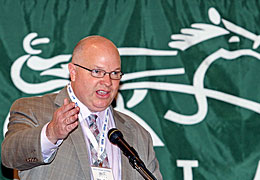Day one of USTA Board meeting concludes
March 18, 2012,by USTA Communications Department
Columbus, OH — The Board of Directors of the U.S. Trotting Association, in the 74th anniversary year of the organization’s founding, convened here today for its annual business meetings. On the first day of a two-day agenda, the Board seated four new members, debated the use of race-day furosemide, heard reports from the USTA president and key executives, and conducted several committee meetings.

USTA/Mark Hall photo
Driver Jordan Stratton, in green, became the youngest individual ever seated on the USTA Board.
The discussion by the USTA Board of the use of furosemide, commonly known by the trade names SalixTM or LasixTM, came as a response to similar debates in recent months among other racing groups. The ongoing national debate has included the Association of Racing Commissioners passing a model rule last December that prohibits private veterinarians from administering the anti-bleeding medication on race days, but there has been no consensus formed within either the Thoroughbred or Standardbred industries about passing and enforcing such a rule.
Sunday’s discussion was led by USTA director Joseph Faraldo, and included a panel consisting of Dr. Alice Stack of Michigan State University, an expert on exercise-induced bleeding, Dr. Jay Baldwin, a practicing equine veterinarian, and Alan J. Leavitt, a USTA director who is a member of the Kentucky Racing Commission, chairs the Association of Racing Commissioners Standardbred Racing Committee, and is also a director of the Racing Medication and Testing Consortium.
Dr. Stack noted that furosemide is the only known drug that has been proved effective in treating “bleeders,” who are very common in both Standardbred and Thoroughbred racing. “Eighty percent of racehorses bled when using a placebo, as opposed to only 55.3 percent who used furosemide,” she said, citing a British study of Thoroughbreds.
Dr. Baldwin, who is an equine practitioner with clients in the Mid-Atlantic states, also noted that one criticism of furosemide has effectively been proven false: “It’s no longer a masking agent for other drugs because today’s testing uses better technology,” he said.
In the end, the question was referred to the U.S. Trotting Association’s Regulatory Committee, which after brief discussion established the USTA’s policy on furosemide use, saying, in part, “The race day use of the therapeutic substance furosemide under controlled condition be continued as the most effective and humane treatment of the racehorse.”

USTA/Mark Hall photo
USTA Executive Vice President and CEO Mike Tanner spoke about several key association projects.
USTA Executive Vice President and CEO Mike Tanner, speaking at today’s opening session, spoke about several key association projects, including the expansion of online services, the Strategic Wagering Program and Back to the Track that have all served the membership and the sport. He also suggested that the USTA should make — as part of its mission statement — the increase in participation in the sport by new owners and “driving” the growth of handle, which as Tanner said, “is what everything grows out of.”
As part of its opening business, the Board seated four new members: They included Kevin Mack, a 48-year industry veteran who currently serves as race secretary at Hoosier Park; George Ducharme, a veteran New England horseman; Fred Nichols, director of racing for Hollywood Slots Hotel and Raceway in Bangor, Maine; and Jordan Stratton, whose youth is complemented by his sulky skills, evidenced by his becoming one of the sport’s youngest drivers to reach 1,000 wins.
Stratton, who is 103 days short of his 25th birthday, became the youngest individual ever seated on the USTA Board, lowering the record held by another current director, Northfield Park’s Brock Milstein, who had just turned 25 when he joined the Board in 2001.
There were no elections held this year due to the lack of challenges, and USTA President Phil Langley was not up for reelection after having been elected to a third four-year term last year. Other officers, all elected to one-year terms, continued in office: Ivan Axelrod (District 3, California) as chairman, Russell Williams (District 7, Pennsylvania) as vice chairman, Richard “Dick” Brandt (District 1, Ohio) as treasurer and USTA deputy registrar Barbara Brooks as secretary.
The Driver-Trainer, Pari-Mutuel, Regulatory and Registration and Owners-Breeders Committees spent the balance of the afternoon meeting to discuss their individual agendas and proposed rule changes. More committees, including Fairs, Rules and Finance, will meet Monday morning, followed by an awards luncheon, the Communications Committee meeting and the final session of the USTA Board, which will ratify committee reports and approve the annual operating budget before adjourning.
As it did today, the USTA will offer live, online video streaming of some of Monday’s proceedings, starting at approximately 1:30 p.m., eastern, when the Communications Committee convenes. Streaming will continue through the end of the final session of the full Board of Directors, when the meetings are officially adjourned.
- USTA Board wraps up annual meetings (Monday, March 19, 2012)
Marketing efforts were both debated and unveiled on the final day of the U.S. Trotting Association annual Board of Directors meeting on Monday afternoon.
- Full text of the USTA’s position on the use of furosemide (Lasix, Salix) (Tuesday, March 20, 2012)
On Monday, the full Board of Directors of the U.S. Trotting Association approved the organization’s official position on the use of the anti-bleeding medication furosemide, widely known in the racing industry by the trade names Salix and Lasix.
